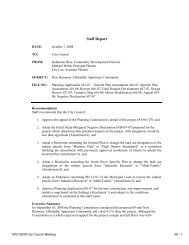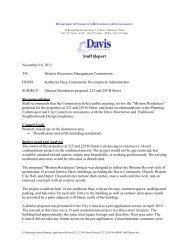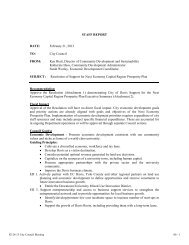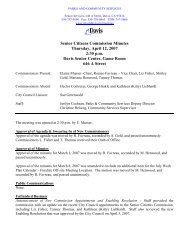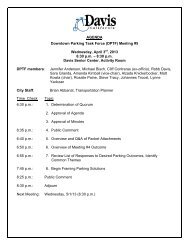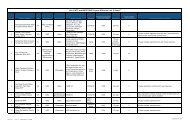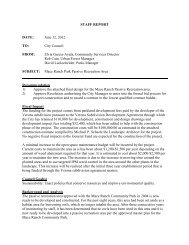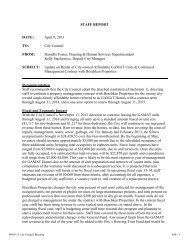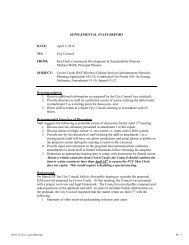10 Draft Integrated Waste Management Plan - City Council - City of ...
10 Draft Integrated Waste Management Plan - City Council - City of ...
10 Draft Integrated Waste Management Plan - City Council - City of ...
Create successful ePaper yourself
Turn your PDF publications into a flip-book with our unique Google optimized e-Paper software.
2012 Davis <strong>Integrated</strong> <strong>Waste</strong> <strong>Management</strong> <strong>Plan</strong><br />
Data from other jurisdictions that have passed similar carryout bag laws show that this is a successful way to<br />
encourage reusable bags. Washington DC imposed a 5 cent fee on both paper and plastic single-use bags in<br />
2009. Since then they have reduced single use bags by 80%. According to CAW, each Californian uses an<br />
estimated average <strong>of</strong> 375 plastic bags and 72 paper bags every year. In Davis, that equates to an annual total <strong>of</strong><br />
approximately 24.6 million plastic bags and 4.7 million paper bags.<br />
The NRC approved staff’s draft carryout bag ordinance in March 2012. At the September 25, 2012 <strong>City</strong> <strong>Council</strong><br />
meeting, the <strong>Council</strong> directed staff to look into re-writing the ordinance to charge a fee for plastic and paper<br />
single-use bags. They directed staff to come back to <strong>Council</strong> early January with an updated draft ordinance.<br />
It is important to note that if the <strong>Council</strong> does pass a carryout bag ordinance, the ordinance would not likely go<br />
into effect until 6 months to 1 year from ordinance adoption. The <strong>City</strong> could also allow 6 months from<br />
implementation for full compliance, as stores adjust their practices and use up their current supply <strong>of</strong> plastic<br />
carryout bags.<br />
7.2.6 Expanded Polystyrene Reduction<br />
Polystyrene (PS) resin granules impregnated with a blowing agent (typically pentane) creates “expandable (or<br />
“expanded”) polystyrene” (EPS), <strong>of</strong>ten called Styr<strong>of</strong>oam TM (a trademarked form <strong>of</strong> EPS). Expanding beads<br />
fuse together to form the finished product, which is white, and generally made up <strong>of</strong> 90 to 95% air. EPS is<br />
estimated at 0.8% (by weight) <strong>of</strong> the materials landfilled. However, due to its lightweight nature, its volume is<br />
much greater. Small EPS beads are used for cups and containers, medium beads for shape-molded packaging,<br />
and large beads for the expanded loose-fill packaging (peanuts). It insulates, is lightweight, and resists<br />
moisture. Loose-fill peanuts sold in California that contain recycled material are <strong>of</strong>ten colored green.<br />
Polystyrene food packaging is lightweight and aerodynamic, so it is easily blown into gutters and storm drains.<br />
Polystyrene is also very brittle, so when littered it quickly breaks into small pieces making cleanup very<br />
difficult. Plastic litter is seen as a threat to natural ecosystems. Wildlife may mistake plastic litter for food, and<br />
may ingest small or large pieces. The plastic does not break down in their digestive system, but <strong>of</strong>ten lingers,<br />
leading to reduced appetite, reduced nutrient absorption, and ultimately death by starvation. According to a<br />
California Department <strong>of</strong> Transportation study during 1998–2000, polystyrene represented 15%<strong>of</strong> the total<br />
volume <strong>of</strong> litter recovered from the storm drains. In 1999, the U.S. Coastal Clean-Up program reported that 2%<br />
<strong>of</strong> the litter picked up was foam cups.<br />
DRAFT<br />
The 2008 <strong>Waste</strong> Characterization Study commissioned by CIWMB does not specifically call out polystyrene as<br />
a material type. Rather it is listed under two different material types:<br />
#3-#7 Other Containers means plastic containers other than sealed containers and #3-#7 buckets <strong>of</strong> five<br />
gallons or less in size, made <strong>of</strong> types <strong>of</strong> plastic other than HDPE (high-density polyethylene) or PETE<br />
(polyethylene terephthalate) that include boxes, clamshells, jars, bottles, and cartons. Items may be<br />
made <strong>of</strong> PVC (polyvinyl chloride), LDPE (low-density polyethylene), PP (polypropylene), PS<br />
(polystyrene), or mixed resins. When marked for identification, these items may bear the number 3, 4, 5,<br />
6, or 7 in the triangular recycling symbol and may also bear the letters PS, PP, PVC, etc. Examples<br />
include bakery packaging with hinged lids, hardware and fastener packaging, food containers such as<br />
bottles for salad dressings and vegetable oils, flexible and brittle yogurt cups, syrup bottles, margarine<br />
tubs, microwave food trays, and clamshell-shaped fast food containers. This type also includes some<br />
shampoo containers, vitamin bottles, foam egg cartons, and clamshell-like muffin containers.<br />
Page | 7-62



